The automotive industry has long been a battleground for technological supremacy, where the sharpness of innovation can make or break the competitive edge. As we race into the future, cutting technology has become a linchpin for success, and keeping abreast of the latest trends is not just advantageous—it’s essential. This comprehensive guide delves deep into the fabric of automotive cutting technology, cutting through the noise to bring you the forefront of industry evolution.
The Evolution of Precision: A Brief Overview
Once the domain of sheer manpower, the evolution of cutting technology in the automotive sector has been nothing short of revolutionary. From the gritty clang of manual shears to the soft hum of laser precision, this transformative journey has been marked by milestones that continue to redefine manufacturing norms.
Staying Competitive in a Sharp Market
In a world where efficiency and precision are the new currency, staying current with cutting technology trends is not merely for advancement but survival. This guide aims to equip you with knowledge, from overarching innovations to nuanced details, ensuring your place at the vanguard of the automotive industry.
What’s Driving Innovation in Automotive Cutting Technology?
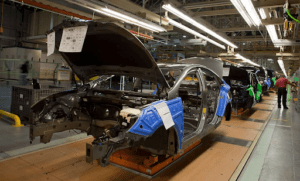
In the relentless pursuit of excellence, a trinity of forces – market demands, environmental regulations, and technological breakthroughs, conspires to drive innovation in automotive cutting technology.
The Catalysts of Change: Efficiency, Precision, and Automation
Here, the trifecta of efficiency, precision, and automation forms the backbone of new trends. Each factor feeds into the other, crafting a synergistic ecosystem where innovation thrives. In the subsequent sections, we unearth the key influences shaping the cutting-edge of tomorrow.
What Are the Latest Materials in Automotive Manufacturing?
A new era of automotive manufacturing is upon us, heralded by the introduction of materials that promise lighter, stronger, and more sustainable vehicles.
The Vanguard of Materials: Meeting the Cutting Challenge
Advanced High-Strength Steels (AHSS)
Aluminum and its alloys
Carbon Fiber Composites
Magnesium alloys
Titanium alloys
Each of these materials brings its own set of cutting requirements, challenging manufacturers to adapt or be left behind.
How Are New Materials Influencing Cutting Technology?
The impact of new materials on cutting technology is undeniable, presenting both hurdles and breakthroughs.
Case Studies: The Response of Innovation
Industry adaptation has been swift and ingenious, with case studies highlighting the leaps in technology devised to tackle these new challenges. From laser precision to waterjet versatility, the answers lie in understanding the demands of each material.
How Is Laser Cutting Revolutionizing Automotive Fabrication?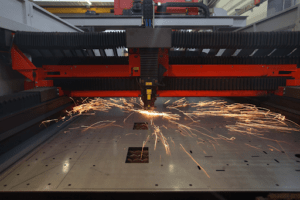
Laser cutting stands as a beacon of progress in automotive fabrication, reshaping the way we think about material transformation.
The Laser Cutting Evolution: A Bullet List of Progression
Design and Prototyping: Enhanced precision in the early stages
Component Cutting: Increased speed and accuracy
Assembly Line Integration: Streamlined processes reducing time and waste
Quality Control: Superior inspection and consistency
Each stage bears the hallmark of laser technology’s impact on the manufacturing process.
What Types of Laser Cutters Are Pioneering in the Automotive Sector?
The automotive industry’s foray into laser cutting is characterized by a range of pioneering technologies, each with its set of operational nuances.
Fiber Laser Cutters
Characterized by their energy efficiency and precision in cutting reflective metals, fiber laser cutting are gaining prominence in automotive manufacturing.
CO2 Laser Cutters
CO2 laser cutters offer a tried-and-tested technology suitable for a wide range of materials, balancing performance with operational costs.
Nd:YAG Laser Cutters
These cutters are known for their versatility and are particularly adept at handling complex cutting tasks, despite their higher operational costs.
What Innovations Exist in Waterjet Cutting for Automotive Parts?
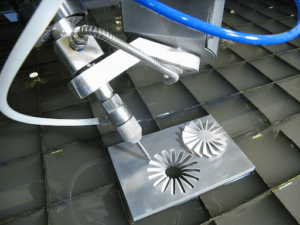
Waterjet cutting technology, with its capacity for precision and material versatility, has emerged as a formidable player in automotive parts manufacturing.
The Waterjet Advantage: Precision and Versatility
Even in the shadow of laser cutting, waterjet technology carves its niche, offering a cold-cutting alternative that negates thermal distortion and opens up possibilities for a broader range of materials.
Is Waterjet Cutting a Feasible Alternative to Laser Cutting in the Automotive Industry?
The debate between laser and waterjet cutting for the automotive industry is not about a clear winner but finding the right tool for the job.
Efficiency, Cost, and Suitability: A Comparative Analysis
Waterjet cutting stands its ground when it comes to certain materials and complexities, offering a compelling case for its use alongside or instead of laser options.
What Role Does Robotics Play in Automotive Cutting Processes?
The integration of robotics into cutting systems is nothing short of a revolution, embodying the next leap forward in manufacturing automation.
Robotic Precision: Enhancing Efficiency
Examples of robotic cutting technology in action today reveal an unprecedented level of precision and efficiency, marking a new epoch in automotive manufacturing.
Are Ultrasonic Cutting Methods Gaining Traction in Automotive Manufacturing?
Ultrasonic cutting technology is cutting through the noise, presenting an innovative method for slicing through softer materials and intricate designs.
The Sonic Scalpel: An Analysis of Ultrasonic Applications
Despite limitations with certain automotive materials, ultrasonic cutting offers unique benefits that cannot be ignored, potentially transforming specific manufacturing niches.
What Are the Safety Innovations in Automotive Cutting Technology?
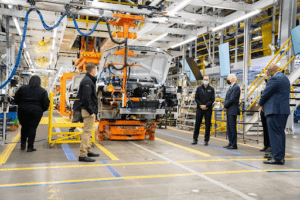
In the realm of cutting technology, innovation is synonymous with safety, with new protocols and equipment becoming as crucial as the cutting tools themselves.
The Bullet List of Safety Milestones:
Enhanced Personal Protective Equipment (PPE)
Automated Emergency Stop Features
Advanced Training Simulators
Each innovation marks a step toward a safer tomorrow for operators in the industry.
How Are Automotive Manufacturers Reducing Waste with Advanced Cutting Techniques?
The role of precision cutting as a champion of material conservation is becoming increasingly clear, with waste reduction being both an economic and environmental victory.
The Statistics of Sustainability: Case Studies in Waste Reduction
Empirical evidence underscores the significance of advanced cutting techniques, revealing a compelling narrative of waste reduction and its benefits.
What Are the Economic Impacts of New Cutting Technologies on the Automotive Industry?
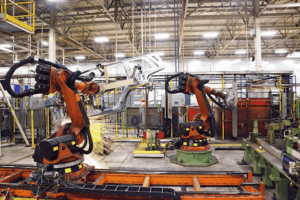
The introduction of new cutting technologies brings with it an intricate dance of cost and benefit, demanding a keen understanding of long-term economic impacts.
Balancing the Scales: Cost-Effectiveness and ROI
The financial implications of adopting new cutting technologies are profound, with initial setup costs often overshadowed by the promise of long-term gains.
Can Investment in Advanced Cutting Technology Be Justified for Small to Medium Enterprises (SMEs)?
For SMEs, the question of scaling cutting technology to fit their scope is a crucial consideration.
The SME Conundrum: Scaling Innovations
The discussion around scaling technology for different sizes of automotive manufacturers is vital, as it can determine the trajectory of growth and innovation for smaller players.
What Is the Future of Cutting Technology in the Automotive Industry?
The future of automotive cutting technology is not written in stone but predicted in trends, expert opinions, and the constant pulse of innovation.
Peering into Tomorrow: Insights and Predictions
Drawing from trade shows, expert interviews, and research papers, we forge a glimpse into the not-so-distant future of automotive cutting technology, a future ripe with potential and poised for unexpected turns.
How to Choose the Right Cutting Technology for Your Automotive Manufacturing Needs?
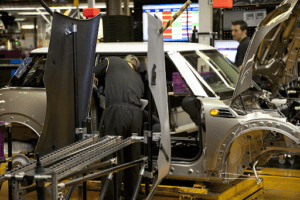
For decision-makers, selecting the most appropriate cutting technologies is a strategic process that demands insight and foresight.
What Are the Mistakes to Avoid When Selecting a Cutting System?
Venturing into the procurement of cutting systems for automotive manufacturing can be fraught with pitfalls. The journey from selection to implementation is often a complex one, demanding a keen understanding of both the technologies and the specific needs they serve. One of the cardinal errors is neglecting to match the system capabilities with the intended application, resulting in over-investment in technology that may exceed the requirements, or worse, under-serving them.
Moreover, overlooking the maintenance and operating costs, which can quickly accumulate, is another misstep. The allure of cutting-edge technology may overshadow the practical considerations of upkeep, which in the long run can place an undue financial strain on the manufacturer. Equally critical is ignoring the scalability of the system; what works today must also be adaptable for tomorrow’s needs as the business grows and evolves.
To skirt these common errors:
Thoroughly assess the material types and thicknesses most frequently encountered in your operations.
Consider the versatility of the cutting system; can it adapt to potential future materials?
Evaluate the total cost of ownership, not just the purchase price.
Scrutinize the system’s expansion capabilities and its alignment with your growth trajectory.
Case Studies: Success Stories of Cutting Technology Implementation
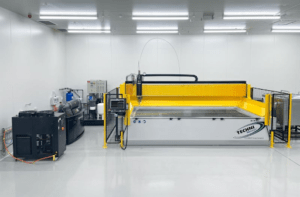
Beyond theoretical discussions, the proof of the pudding is in the eating. Several automotive giants and agile start-ups alike have reaped the benefits of strategically implementing advanced cutting technologies. For instance, a European car manufacturer recently transitioned to laser cutting for complex components. The result? A 30% reduction in production time and a significant decrease in waste materials, catapulting both profitability and environmental sustainability.
Similarly, a North American firm’s adoption of robotic waterjet cutting systems has not only enhanced precision but has also brought about a remarkable improvement in worker safety. These cases underscore the transformative impact cutting technologies can have when effectively harnessed.
To glean lessons from these narratives:
Notice the alignment between technology and the manufacturer’s specific goals.
Observe the importance placed on employee training and safety protocols.
Reflect on the integration of cutting systems within existing production lines.
Conclusion
Navigating the labyrinth of cutting technology trends in the automotive industry is no mean feat. However, it is a journey that manufacturers must embark upon to stay competitive and meet the ever-evolving demands of the market. From laser precision to the brute force of waterjet cutting, from the finesse of ultrasonics to the robustness of robotics, the landscape is as varied as it is dynamic.
This guide has traversed the broad avenues of innovation and peered into the granular specifics of materials and machines. The drive towards efficiency, precision, automation, and safety is relentless, with each advance opening new possibilities and presenting fresh challenges. As we stand on the precipice of future developments, one thing is crystal clear: the willingness to adapt and innovate is not merely an asset but a necessity.













More Stories
Some Ways How Motorists End Up in Collisions at U-Turns
Maximise Margins with Proven PPF Tactics
Finding the Car Boot Release Button – Tips and Tricks